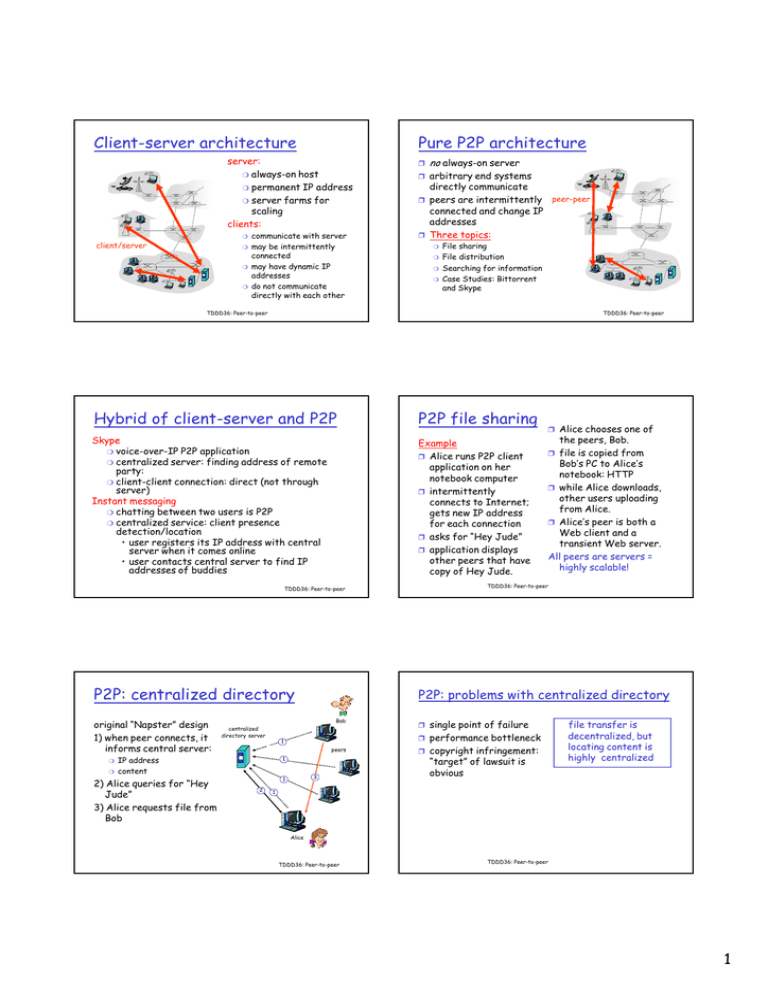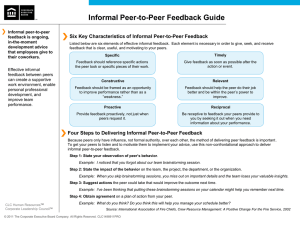Client-server architecture Pure P2P architecture no
advertisement

Client-server architecture
Pure P2P architecture
server:
❍ always-on host
❍ permanent IP address
❍ server farms for
scaling
clients:
❍
client/server
❍
❍
❍
communicate with server
may be intermittently
connected
may have dynamic IP
addresses
do not communicate
directly with each other
❒
no always-on server
❒ arbitrary end systems
directly communicate
❒ peers are intermittently
❍
❍
❍
❍
File sharing
File distribution
Searching for information
Case Studies: Bittorrent
and Skype
TDDD36: Peer-to-peer
TDDD36: Peer-to-peer
Hybrid of client-server and P2P
P2P file sharing
Skype
❍ voice-over-IP P2P application
❍ centralized server: finding address of remote
party:
❍ client-client connection: direct (not through
server)
Instant messaging
❍ chatting between two users is P2P
❍ centralized service: client presence
detection/location
• user registers its IP address with central
server when it comes online
• user contacts central server to find IP
addresses of buddies
Example
❒ Alice runs P2P client
application on her
notebook computer
❒ intermittently
connects to Internet;
gets new IP address
for each connection
❒ asks for “Hey Jude”
❒ application displays
other peers that have
copy of Hey Jude.
TDDD36: Peer-to-peer
P2P: centralized directory
original “Napster” design
1) when peer connects, it
informs central server:
❍
❍
Bob
peers
1
2
the peers, Bob.
❒ file is copied from
Bob’s PC to Alice’s
notebook: HTTP
❒ while Alice downloads,
other users uploading
from Alice.
❒ Alice’s peer is both a
Web client and a
transient Web server.
All peers are servers =
highly scalable!
TDDD36: Peer-to-peer
❒ single point of failure
❒ performance bottleneck
1
3
1
❒ Alice chooses one of
P2P: problems with centralized directory
centralized
directory server
IP address
content
2) Alice queries for “Hey
Jude”
3) Alice requests file from
Bob
peer-peer
connected and change IP
addresses
❒ Three topics:
❒ copyright infringement:
“target” of lawsuit is
obvious
file transfer is
decentralized, but
locating content is
highly centralized
1
Alice
TDDD36: Peer-to-peer
TDDD36: Peer-to-peer
1
Gnutella: protocol
Query flooding: Gnutella
❒ fully distributed
❍ no central server
❒ public domain protocol
❒ many Gnutella clients
implementing protocol
overlay network: graph
❒ edge between peer X
and Y if there’s a TCP
connection
❒ all active peers and
edges form overlay net
❒ edge: virtual (not
physical) link
❒ given peer typically
connected with < 10
overlay neighbors
File transfer:
HTTP
❒ Query message
sent over existing TCP
connections
❒ peers forward
Query message
❒ QueryHit
sent over
reverse
path
Query
QueryHit
Query
QueryHit
Scalability:
limited scope
flooding
TDDD36: Peer-to-peer
TDDD36: Peer-to-peer
Gnutella: Peer joining
Hierarchical Overlay
joining peer Alice must find another peer in
Gnutella network: use list of candidate peers
2. Alice sequentially attempts TCP connections with
candidate peers until connection setup with Bob
3. Flooding: Alice sends Ping message to Bob; Bob
forwards Ping message to his overlay neighbors
(who then forward to their neighbors….)
❒ peers receiving Ping message respond to Alice
with Pong message
4. Alice receives many Pong messages, and can then
setup additional TCP connections
❒ between centralized
1.
index, query flooding
approaches
❒ each peer is either a
group leader or assigned
to a group leader.
❍
❍
TCP connection between
peer and its group leader.
TCP connections between
some pairs of group leaders.
❒ group leader tracks
content in its children
ordinary peer
group-leader peer
neighoring relationships
in overlay network
TDDD36: Peer-to-peer
TDDD36: Peer-to-peer
Distributed Hash Table (DHT)
DHT Identifiers
❒ DHT = distributed P2P database
❒ Assign integer identifier to each peer in range
[0,2n-1].
❒ Database has (key, value) pairs;
❍
❍
❍
key: ss number; value: human name
key: content type; value: IP address
Each identifier can be represented by n bits.
❒ Require each key to be an integer in same range.
❒ Peers query DB with key
❍ DB returns values that match the key
❒ Peers can also insert (key, value) peers
TDDD36: Peer-to-peer
❒ To get integer keys, hash original key.
❍
❍
eg, key = h(“Led Zeppelin IV”)
This is why they call it a distributed “hash” table
TDDD36: Peer-to-peer
2
How to assign keys to peers?
Circular DHT (1)
1
❒ Central issue:
❍
Assigning (key, value) pairs to peers.
3
15
❒ Rule: assign key to the peer that has the
closest ID.
❒ Convention in lecture: closest is the
immediate successor of the key.
❒ Ex: n=4; peers: 1,3,4,5,8,10,12,14;
❍
❍
key = 13, then successor peer = 14
key = 15, then successor peer = 1
4
12
5
10
8
only aware of immediate successor
and predecessor.
❒ “Overlay network”
❒ Each peer
TDDD36: Peer-to-peer
TDDD36: Peer-to-peer
Circular DHT with Shortcuts
Circle DHT (2)
1
O(N) messages
on avg to resolve
query, when there
are N peers
0001
Who’s
responsible
for key 1110 ?
I am
15
0011
4
1111
12
5
1110
10
0100
1110
1110
1100
8
❒ Each peer keeps track of IP addresses of predecessor,
1110
1110
Define closest
as closest
successor
Who’s
responsible
for key 1110?
3
0101
1110
1010
successor, short cuts.
❒ Reduced from 6 to 2 messages.
❒ Possible to design shortcuts so O(log N) neighbors,
O(log N) messages in query
1000
TDDD36: Peer-to-peer
Peer Churn
P2P Case study: Skype
1
3
15
4
12
•To handle peer churn, require
each peer to know the IP address
of its two successors.
• Each peer periodically pings its
two successors to see if they
are still alive.
5
10
TDDD36: Peer-to-peer
8
❒ Peer 5 abruptly leaves
❒ Peer 4 detects; makes 8 its immediate successor;
asks 8 who its immediate successor is; makes 8’s
immediate successor its second successor.
❒ What if peer 13 wants to join?
TDDD36: Peer-to-peer
Skype clients (SC)
❒ inherently P2P: pairs
of users communicate.
❒ proprietary
Skype
login server
application-layer
protocol (inferred via
reverse engineering)
❒ hierarchical overlay
with Supernodes
(SNs)
❒ Index maps usernames
to IP addresses;
distributed over SNs
Supernode
(SN)
TDDD36: Peer-to-peer
3
Scalable Content Delivery
Peers as relays
Motivation
❒ Problem when both
❒ Use of Internet for content delivery is massive … and
Alice and Bob are
behind “NATs”.
❍
becoming more so (e.g., recent projection that by 2013,
90% of all IP traffic will be video content)
NAT prevents an outside
peer from initiating a call
to insider peer
❒ How to make scalable and efficient?
❍
❒ Solution:
❍ Using Alice’s and Bob’s
SNs, Relay is chosen
❍ Each peer initiates
session with relay.
❍ Peers can now
communicate through
NATs via relay
Here: Cost efficiency (e.g., energy efficiency) ...
❒ Variety of approaches: broadcast/multicast, batching,
replication/caching (e.g. CDNs), P2P, peer-assisted, …
❒ In these slides:
❍
❍
❍
BitTorrent (peer-to-peer)
Peer-assisted streaming
Server-based solutions (aggregation and replication)
TDDD36: Peer-to-peer
File Distribution: Server-Client vs P2P
Question : How much time to distribute file
from one server to N peers?
us: server upload
bandwidth
Server
u1
d1
u2
us
ui: peer i upload
bandwidth
d2
di: peer i download
bandwidth
File, size F
dN
uN
Network (with
abundant bandwidth)
TDDD36: Peer-to-peer
File distribution time: server-client
Server
❒ server sequentially
sends N copies:
❍
u1 d1 u2
d2
F
us
NF/us time
dN
❒ client i takes F/di
Network (with
abundant bandwidth)
uN
time to download
Time to distribute F
to N clients using
client/server approach = dcs = max { NF/us, F/min(di) }
i
increases linearly in N
(for large N)
TDDD36: Peer-to-peer
File distribution time: P2P
Server-client vs. P2P: example
Client upload rate = u, F/u = 1 hour, us = 10u, dmin ≥ us
Server
copy: F/us time
❒ client i takes F/di time
to download
❒ NF bits must be
downloaded (aggregate)
❒ fastest possible upload rate: us +
u1 d1 u2
F
us
d2
Network (with
abundant bandwidth)
dN
uN
Σu
i
3.5
Minimum Distribution Time
❒ server must send one
TDDD36: Peer-to-peer
P2P
Client-Server
3
2.5
2
1.5
1
0.5
0
dP2P = max { F/us, F/min(di) , NF/(us +
i
Σu ) }
0
5
10
15
20
25
30
35
i
N
TDDD36: Peer-to-peer
TDDD36: Peer-to-peer
4
File distribution: BitTorrent
❒ P2P file distribution
BitTorrent (1)
torrent: group of
tracker: tracks peers
peers exchanging
chunks of a file
participating in torrent
❒ file divided into 256KB
chunks.
❒ peer joining torrent:
has no chunks, but will accumulate them over time
registers with tracker to get list of peers,
connects to subset of peers (“neighbors”)
❒ while downloading, peer uploads chunks to other
peers.
❒ peers may come and go
❒ once peer has entire file, it may (selfishly) leave or
(altruistically) remain
❍
obtain list
of peers
❍
trading
chunks
peer
TDDD36: Peer-to-peer
BitTorrent-like systems
TDDD36: Peer-to-peer
Download using BitTorrent
Background: Incentive mechanism
❒ File split into many smaller pieces
❒ Pieces are downloaded from both seeds and downloaders
❒ Distribution paths are dynamically determined
❒ Establish connections to large set of peers
❍ At each time, only upload to a small (changing) set of
peers
Based on data availability
❍
❒ Rate-based tit-for-tat policy
❍ Downloaders give upload preference to the downloaders
that provide the highest download rates
Downloader
Seed
Downloader
Seed
Downloader
Highest download rates
Torrent
Arrivals
Pick top four
(x downloaders; y seeds)
Departures
Downloader
Seed residence
time
Download time
TDDD36: Peer-to-peer
BitTorrent (2)
Download using BitTorrent
Background: Piece selection
Peer 1:
1
2
3
Peer 2:
1
2
3
Peer N :
1
2
3
Pieces in neighbor set: (1)
1
2
3
(2) (1)
(2)
…
k
…
K
…
k
…
K
…
k
…
K
…
k
…
from
(2) (3) (2)
K
Optimistic unchoke
to
❒ Rarest first piece selection policy
❍ Achieves high piece diversity
❒ Request pieces that
❍ the uploader has;
❍ the downloader is interested (wants); and
❍ is the rarest among this set of pieces TDDD36: Peer-to-peer
Pulling Chunks
❒ at any given time,
different peers have
different subsets of
file chunks
❒ periodically, a peer
(Alice) asks each
neighbor for list of
chunks that they have.
❒ Alice sends requests
for her missing chunks
❍ rarest first
Pick one at random
TDDD36: Peer-to-peer
Sending Chunks: tit-for-tat
❒ Alice sends chunks to four neighbors
currently sending her chunks at the
highest rate
v re-evaluate top 4 every 10 secs
❒ every 30 secs: randomly select
another peer, starts sending chunks
v newly chosen peer may join top 4
v “optimistically unchoke”
TDDD36: Peer-to-peer
5
Live Streaming
BitTorrent: Tit-for-tat
(1) Alice “optimistically unchokes” Bob
(2) Alice becomes one of Bob’s top-four providers; Bob reciprocates
(3) Bob becomes one of Alice’s top-four providers
using BT-like systems
Internet
piece
upload/downloads
Media player
queue/buffer
Buffer window
❒ Live streaming (e.g., CoolStreaming)
❍ All peers at roughly the same play/download position
With higher upload rate,
can find better trading
partners & get file faster!
• High bandwidth peers can easily contribute more …
❍
(relatively) Small buffer window
• Within which pieces are exchanged
TDDD36: Peer-to-peer
Peer-assisted VoD streaming
Some research questions ...
TDDD36: Peer-to-peer
Streaming Analysis
❒ Can BitTorrent-like protocols provide scalable on-
❒ Media Streaming Progress (MSP) depends
demand streaming?
on two different things:
❒ How sensitive is the performance to the application
❍
configuration parameters?
❍ Piece selection policy
❍ Peer selection policy
❍ Upload/download bandwidth
❍
MSP = DP
❒ What is the user-perceived performance?
❍
❍
Download Progress (DP)
Sequential Progress (SP)
(useful media pieces
per unit time)
Start-up delay
Probability of disrupted playback
x
(pieces obtained
per unit time)
SP
(useful media pieces
per pieces obtained)
❒ These two can (sometimes) be analyzed separately
ACM SIGMETRICS 2008; IFIP Networking 2007; IFIP Networking 2009
TDDD36: Peer-to-peer
TDDD36: Peer-to-peer
Piece Selection Policy
Baseline Protocol
Example Results
Piece Selection (1)
❒ Which piece to upload?
❒ Basic tradeoff
1
Piece diversity
• Tit-for-tat is most effective with “rarest-first”
❍
In-order requirements
• Streaming is most natural using “in-order”
❒ Baseline policy (from ‘07 paper)
❍ Simple probabilistic policy
• Bias towards earlier pieces
❍
Average Startup Delay
❍
n
0.1
n
Inorder, Rarest
Portion, x%
n
0.01
n
inorder
portion, 90%
portion, 50%
rarest
zipf(1.25)
0.001
n
Zipf(θ)
n
0.0001
Zipf(θ)
0
TDDD36: Peer-to-peer
4
8
12
Client Bandwidth
16
x% inorder
(100-x)% rarest
n
Random with bias towards
earlier pieces
Bias follow Zipf distribution
TDDD36: Peer-to-peer
6
Start-up Rule
Start-up Rule
Intuition
Intuition
The amount of in-order
data received (i.e., the size
of the in-order buffer)
The amount of in-order
data received
The total amount of data received
data
data
The total amount of data received
Required amount of in-order
data, if received at constant rate
x
x
The amount of data played out if
playback starts at time T
T
T
time
❒ In-order buffer
❍ Contains all pieces up to the first missing piece
❒ The rate the size of the in-order buffer increases
is expected to increase with time (as holes are
filled)
time
❒ Estimate the rate using a “long-term” average (LTA)
❒ Adjusts start-up delay based on network conditions
❒ Enough (in-order) pieces to get a reasonable rate estimate
TDDD36: Peer-to-peer
TDDD36: Peer-to-peer
Request aggregation techniques
The Case for Distributed
Digital Fountains (example)
Potentially useful for hot files receiving multiple requests closely
spaced in time
“Efficiency”? … use of a relatively small number of distributed
servers, using request aggregation, may be as, or more, “energy
friendly” than peer-assisted designs
S
S
❒ Allow use of service aggregation
❍ Total work may become important (e.g.,
energy/carbon consumption)
S
S
C
❒ Energy costs
❍ Green data centers (close to renewable
energy source, for example)
❍ Energy proportional data centers
S
S
C
S
C
S C
C
C C
C
Idea is to serve multiple requests together (entirely or partially)
Network transmissions may be multicast (in which case both
server and network resources saved), or unicast (in which case
only server resources, such as disk bandwidth, are saved)
S
Consider delivery of a hot file, and suppose want to minimize:
❒ “server bandwidth” usage for that file
❒ maximum client delay (download time)
❒ Also, greater control of content
TDDD36: Peer-to-peer
TDDD36: Peer-to-peer
Cyclic Multicast Protocols
Cyclic Multicast Protocols
Without Losses
With Losses
Operation: The file is cyclically
File A
scheduled on a channel
- Clients listen until fully served
1 2 3 4 5 6 7 8
5
Operation: The file is cyclically
File A
File A
1 2 X X X 6 7 8
1 2 3 4 5 6 7 8
6
5
7
4
8
3
S
7
6
5
4
3
C
2 1 8 7 6
1
Server
7
4
8
TDDD36: Peer-to-peer
S
7
6
4
3
C
2 1 8 7 6
1
2
Client
1 2 X X X 6 7 8
6
3
2
File A
scheduled on a channel
- Clients listen until fully served
Server
5
losses
Client
TDDD36: Peer-to-peer
7
A Digital Fountain Approach
Fountain service
Operation: The file data is
File A
1 2 3 4 5 6 7 8
File A
erasure coded and clients listen to
the channel until having retrieved
“enough” pieces to re-create the
original file
Basic fountain protocol (with turn of when idle)
1 2 3 4 5 6 7 8
Cyclic/l: (parameter: transmission rate) (e.g., “digital fountain” of
Enc.
Byers et al.)
Dec.
request arrivals
S
Server
C
losses
Client
•
Optimal if clients are not subject to additional batch delays
•
Main drawback: Periods during which relatively few clients are
being served
TDDD36: Peer-to-peer
TDDD36: Peer-to-peer
A final note …
Locality vs. aggregation
❒ If you are interested in one (or more)
But now have server selection problem …
❒ network resource usage is minimized by selecting nearest server
❒ server resource usage is minimized by directing closely-spaced
requests for the same file to the same server
S
S
S
S
C
S
S
C
S
C
S C
C
C C
C
S
ACM TOMCCAP 2010; IEEE/ACM MASCOTS 2010
TDDD36: Peer-to-peer
topic(s) in this course, please do not
hesitate to contact me ...
❒ There are always lots interesting problems
to work on (for an exjobb, for example)!!!
❒ You can also find out more about my
research on my Website:
www.cs.usask.ca/grads/nic169/research.html
TDDD36: Peer-to-peer
8

